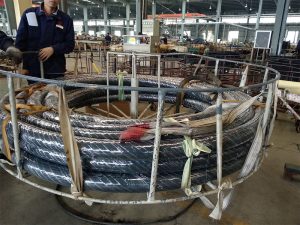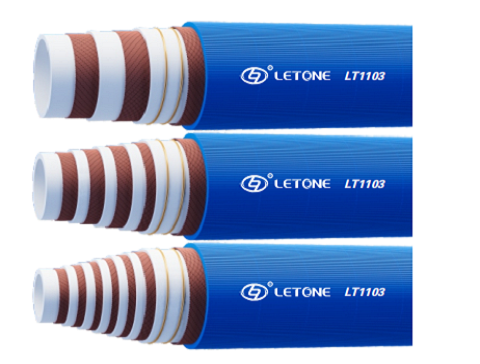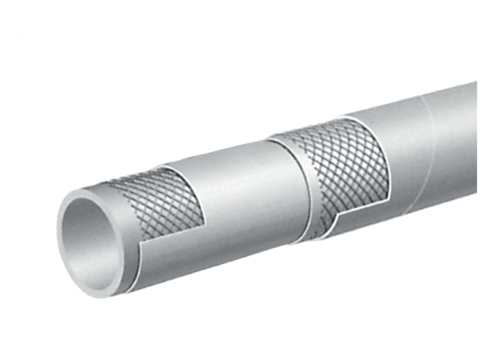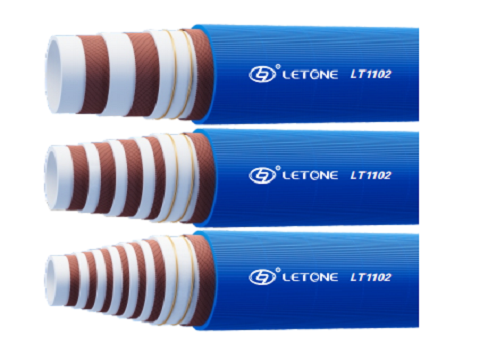In modern construction, concrete is the main building material, and its transportation and pouring efficiency directly affects the progress and quality of the project. Concrete conveying hoses, as important tools in this process, play a crucial role. This article will delve into the structure, types, usage precautions, and importance of concrete conveying hoses in the construction industry.
What is a concrete conveying hose?
Concrete conveying hose, also known as concrete pump conveying hose, is a specially designed hose mainly used to transport concrete from the concrete pump to the construction site. Its design aims to withstand high pressure and maintain the fluidity of concrete during transportation, ensuring that the concrete can be evenly discharged. The main material of this hose is usually synthetic rubber, and the outer layer is made of car tire material to improve its wear resistance and tear resistance.
Types of concrete conveying hoses
According to different usage scenarios and requirements, concrete conveying hoses can be divided into various types, mainly including:
1. Standard type concrete conveying hose: suitable for general construction sites and pouring needs, this hose has multiple specifications for diameter and length selection.
2. High pressure resistant concrete conveying hose: used for projects that require high-pressure conveying, especially in high-altitude pouring or large-scale infrastructure construction, requiring the hose to have higher pressure bearing capacity.
3. Wear resistant concrete conveying hose: Used in working conditions with severe wear, such as large-scale pouring molding. This type of hose has a more robust outer design to resist wear and tear.
4. Flexible concrete conveying hose: suitable for projects that require frequent turns or narrow space operations. This hose has strong flexibility and is easy to operate.
 Structure and materials of concrete conveying hoses
Concrete conveying hoses usually consist of two layers of structure, inner and outer:
-Inner layer: Made of high-quality synthetic rubber material, it has excellent wear resistance and compressive strength, ensuring smooth flow of concrete during long-term use.
-Outer layer: Generally, wear-resistant and tear resistant materials are used, such as car tire materials, which can effectively protect the internal structure and reduce the impact of external environment on the conveying hose.
In addition, the joint part of the concrete conveying hose is also an important design element, usually in the form of spiral fixation or clamps to ensure a stable connection between the hose and the concrete pump, and not easy to fall off.
Precautions for using concrete conveying hoses
There are several key considerations when using concrete conveying hoses:
1. Choose the appropriate hose: Select the appropriate type and specification of hose according to the actual needs of the project to avoid losses caused by selecting the wrong model.
2. Regular inspection of hoses: Before each use, check the hoses for wear, cracks, or other damage to ensure safe and reliable use.
3. Avoid excessive bending: During the transportation process, try to avoid excessive bending of the hose, otherwise it may cause poor concrete transportation and even damage to the hose.
4. Cleaning and maintenance: After each use, the concrete conveying hose should be cleaned in a timely manner to prevent concrete residue from solidifying and affecting subsequent use.
5. Proper storage: Unused hoses should be stored in a cool and dry place, avoiding direct sunlight and high temperature environments to extend their service life.
The importance of concrete conveying hoses in the construction industry
The importance of concrete conveying hoses in the construction industry cannot be ignored. With the rapid development of urban construction, the requirements for concrete pouring are becoming increasingly high, which requires concrete conveying hoses to have stronger performance and higher reliability.
1. Improve construction efficiency: By using concrete conveying hoses, high-speed and efficient concrete pouring can be achieved, greatly shortening the construction period and reducing labor costs.
2. Reduce construction risks: Reasonable use of concrete conveying hoses effectively prevents concrete leakage and connection failure, improving construction safety.
3. Ensure concrete quality: By using professional conveying hoses, the fluidity of concrete can be better controlled, thereby improving the quality of concrete and ensuring the safety and stability of various types of buildings.
Future prospects
With the development of technology, the technology of concrete conveying hoses is also constantly innovating. New materials and more advanced manufacturing processes will make concrete conveying hoses more wear-resistant, durable, and environmentally friendly. In addition, intelligence is also an important trend in the future, which will greatly improve the efficiency and safety of concrete transportation through sensors and monitoring systems.
In the current market environment, choosing high-quality concrete conveying hoses has become an investment that cannot be ignored for construction companies. High quality concrete conveying hoses are the foundation for achieving construction goals, both in terms of funding and ensuring project success.
summary
Concrete conveying hose is not only an indispensable tool in construction engineering, but also an important guarantee for ensuring construction safety and improving efficiency. Through a comprehensive understanding of concrete conveying hoses, we can better respond to various challenges in the construction industry and promote the high-quality and efficient completion of engineering projects.
Structure and materials of concrete conveying hoses
Concrete conveying hoses usually consist of two layers of structure, inner and outer:
-Inner layer: Made of high-quality synthetic rubber material, it has excellent wear resistance and compressive strength, ensuring smooth flow of concrete during long-term use.
-Outer layer: Generally, wear-resistant and tear resistant materials are used, such as car tire materials, which can effectively protect the internal structure and reduce the impact of external environment on the conveying hose.
In addition, the joint part of the concrete conveying hose is also an important design element, usually in the form of spiral fixation or clamps to ensure a stable connection between the hose and the concrete pump, and not easy to fall off.
Precautions for using concrete conveying hoses
There are several key considerations when using concrete conveying hoses:
1. Choose the appropriate hose: Select the appropriate type and specification of hose according to the actual needs of the project to avoid losses caused by selecting the wrong model.
2. Regular inspection of hoses: Before each use, check the hoses for wear, cracks, or other damage to ensure safe and reliable use.
3. Avoid excessive bending: During the transportation process, try to avoid excessive bending of the hose, otherwise it may cause poor concrete transportation and even damage to the hose.
4. Cleaning and maintenance: After each use, the concrete conveying hose should be cleaned in a timely manner to prevent concrete residue from solidifying and affecting subsequent use.
5. Proper storage: Unused hoses should be stored in a cool and dry place, avoiding direct sunlight and high temperature environments to extend their service life.
The importance of concrete conveying hoses in the construction industry
The importance of concrete conveying hoses in the construction industry cannot be ignored. With the rapid development of urban construction, the requirements for concrete pouring are becoming increasingly high, which requires concrete conveying hoses to have stronger performance and higher reliability.
1. Improve construction efficiency: By using concrete conveying hoses, high-speed and efficient concrete pouring can be achieved, greatly shortening the construction period and reducing labor costs.
2. Reduce construction risks: Reasonable use of concrete conveying hoses effectively prevents concrete leakage and connection failure, improving construction safety.
3. Ensure concrete quality: By using professional conveying hoses, the fluidity of concrete can be better controlled, thereby improving the quality of concrete and ensuring the safety and stability of various types of buildings.
Future prospects
With the development of technology, the technology of concrete conveying hoses is also constantly innovating. New materials and more advanced manufacturing processes will make concrete conveying hoses more wear-resistant, durable, and environmentally friendly. In addition, intelligence is also an important trend in the future, which will greatly improve the efficiency and safety of concrete transportation through sensors and monitoring systems.
In the current market environment, choosing high-quality concrete conveying hoses has become an investment that cannot be ignored for construction companies. High quality concrete conveying hoses are the foundation for achieving construction goals, both in terms of funding and ensuring project success.
summary
Concrete conveying hose is not only an indispensable tool in construction engineering, but also an important guarantee for ensuring construction safety and improving efficiency. Through a comprehensive understanding of concrete conveying hoses, we can better respond to various challenges in the construction industry and promote the high-quality and efficient completion of engineering projects.







